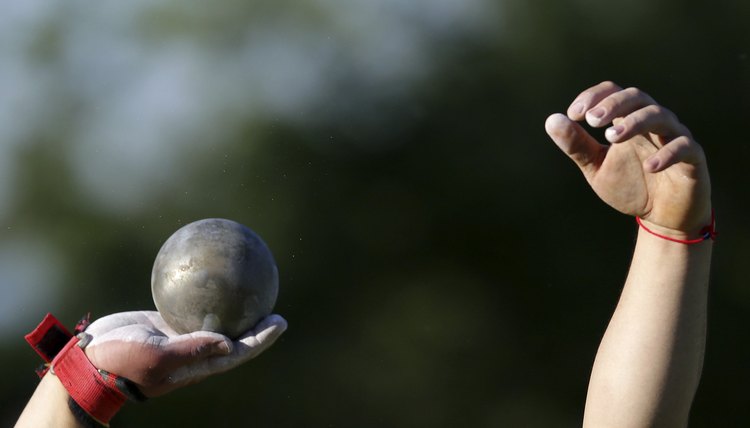How Is the Shot Put Throw Measured?

The shot put is one of several field events that use distance measurements to determine a winner. As with each event, the shot put has a standardized measuring method. Every competition shot put should be measured in the same way. This does not always happen in local meets, but in regional and state high school meets and certainly college meets, the shot put is measured in the same way every time.
Marking
Each athlete receives either three or four throws. If there are finals, athletes will receive three throws in the finals. Results from the preliminary rounds may or may not carry over, depending on state or regional rules. Well-organized meets do not measure each throw. Instead, using pins, workers constantly have the top eight to 10 throws marked. This is done to speed up the process while still ensuring that any throws close together can be differentiated. Competitors who have a top eight or 10 effort are assigned pin numbers and only lose that number if they drop out of the top eight to 10. At the end of the event, the pins are measured and results are known. If the same shot-putter has two similar throws, he may be awarded two pins to ensure the best throw is measured.
Stretching the Tape
Using two helpers, the official of the event will measure each pin. The end of the tape will be placed in the middle of the crater made by the shot. The other helper will pull the tape through the front of the throwing ring to the dot marking the center of the ring. Failure to do this can add inches to throws on the edges of the field. Accuracy is ensured by having all measurements run through the center of the ring.
Point of Measure
Many officials measure the throw from the wrong spot. Some use the outer edge of the toe board, some use the middle, some use the edge of the concrete ring itself. The throw should be measured from the inside of the toe board, because the top of the toe board should not be touched by the body during the throw. Because the tape is pulled through the center of the ring, the location along the inner edge of the toe board can vary from one end to another. This mimics the release point of the thrower. Measurements should be specified to the quarter of an inch. Pins should not be pulled as they are measured so that they can be remeasured by a smaller margin of error in the event of a tie.
Tools for Accuracy
Because of the crossover of distances between regions and states, many larger meets have begun to use spot sticks to measure throws. These sticks make the measurement process faster, but also more consistent. The sticks have a rubber stopper the same height as the toe board. This allows the official to simply walk to the pin, put the stick into the ground and move on once the measurement has occurred. The tape does not move from the raised toe board to ground level. Instead, the tape is always held at the same height at the toe board, making the measurements more consistent.
References
- "Complete Book of Throws"; Jay Silvester; 2003
- "The Shot Put Handbook"; Lawrence Judge and Mike Young; 2010
Writer Bio
JR Landry began writing professionally in 2010 for various websites. He has extensive experience in sports writing, most notably on football and strength training. Landry began a teaching career after earning his Bachelor of Arts in English from Austin College.
